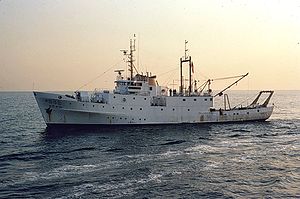- NOAAS Albatross IV (R 342)
-

Albatross IV (R 342)Career (United States) 

Name: Albatross IV (R 342) Namesake: The albatross, a large seabird of the family Diomedeidae Builder: Southern Shipbuilding Company, Slidell, Louisiana Launched: April 1962 Commissioned: 9 May 1963 Decommissioned: 20 November 2008 Status: Inactive Notes: Served in Bureau of Commercial Fisheries 1963-1970
Served in National Oceanic and Atmospheric Administration from 1970 until 2008General characteristics Type: Fisheries research ship Tonnage: 931 gross register tons
300 net register tonsDisplacement: 1,089 tons Length: 187 ft (57 m) Beam: 33 ft (10 m) Draft: 16 ft (4.9 m) Installed power: 1,130 brake horsepower (0.84 megawatt) Propulsion: Two Caterpillar diesel engines, 1 shaft, 150 tons fuel; 125-horsepower (0.09-megawatt) bow thruster Speed: 12 knots (sustained) Range: 4,300 nautical miles (8,000 km) at 12 knots (22 km/h) Endurance: 15 days Boats and landing
craft carried:One launch Complement: 21 (4 NOAA Corps officers, 1 civilian officer, 3 licensed engineers, and 13 other crew members), plus up to 14 scientists[1] Notes: Ice-strengthened hull; 450 kilowatts electrical power NOAA Ship Albtaross IV (R 342) was a fisheries research ship in commission in the Bureau of Commercial Fisheries from 1963 to 1970 and in the National Oceanic and Atmospheric Administration from 1970 to 2008.
Contents
Construction and characteristics
Albatross IV was built at Southern Shipbuilding in Slidell, Louisiana. She was launched in April 1962.
The ice-strengthened hull of the ship was 187 feet (57 meters) long. The ship had a total of 38 bunk spaces. Between the crew and officers mess rooms, the ship could seat 21 for meals. She carried a complement of 21—4 NOAA Corps officers, 1 civilian officer, and 16 crew (including 3 licensed engineers -- and in addition could accommodate up to 14 scientists.
Her deck equipment featured four winches, one boom crane, an A-frame, a J-frame, and a portable gantry. This equipment gave Albatross IV a lifting capacity of up to 10,000 pounds (4,530 kilograms) as well 20,000 feet (6,090 meters) of cable that can pull up to 16,000 pounds (7,250 kilograms). Each of the winches serves a specialized function ranging from trawling and dredging to hydrographic surveys.
In support of her primary mission of fishery and living marine resource research for the National Marine Fisheries Service (NMFS) division of NOAA, the ship had shallow- and deep-water echo sounders, a fishfinder, and an Acoustic Doppler Current Profiler (ADCP). Additional scientific equipment included a thermosalinograph and a fluorometer. She had 800 square feet (74 square meters) of laboratory space with specialty labs for plankton and oceanographic chemistry. A 16-foot (4.8 m) launch was available for utility or rescue operations.
Service
Albatross IV was commissioned into service with the Bureau of Commercial Fisheries on May 9, 1963. When NOAA was established in 1970 and took over the Bureau's assets, she became part of the NOAA fleet.
Based at Woods Hole, Massachusetts, Albatross IV conducted fisheries and living marine resources research off the northeastern coast of the United States.
On May 12, 1986, shipyard workers were working in Albatross IV's marine sanitation device compartment when one of them accidentally set off the compartment's fixed carbon dioxide firefighting system. Although the other workers escaped, one man, Kelly Prince, passed out in the compartment. He would have suffocated, but three members of the ship's crew -- NOAA Corps Lieutenant Dean Smehil, civilian third assistant engineer Daniel J. Parry, and the ship's executive officer -- put on Scott air packs and crawled into the very tight compartment. In moments, Smehil and Parry dragged the unconscious Prince from the compartment to safety, saving his life. For their heroism, Smehil and Parry received the 1986 Department of Commerce Gold Medal.
Albatros IV was decommissioned on November 20, 2008. She now is inactive in NOAA's Atlantic Fleet.
See also
NOAA ships and aircraft Seen docked in Green Cove Springs, FL on January 28, 2011.
Notes
- ^ Per Combat Fleets of the World 1990/1991, the complement was 22 (7 NOAA Corps officers and 15 crew members) plus up to 15 scientists.
References
- Prézelin, Bernard, and A. D. Baker III, eds. The Naval Institute Guide to Combat Fleets of the World 1990/1991: Their Ships, Aircraft, and Armament. Annapolis, Maryland: United States Naval Institute, 1990. ISBN 0 87021 250 8.
- NOAA History, A Science Odyssey: Hall of Honor: Commerce Medals Presented for Lifesaving and the Protection of Property 1955-2000
External links
- "NOAA Ship ALBATROSS IV". January 10, 2006. http://www.moc.noaa.gov/al/index.html. Retrieved May 10, 2006.
Categories:- Ships of the National Oceanic and Atmospheric Administration
- Research vessels of the United States
- Ships built in Louisiana
- 1962 ships
Wikimedia Foundation. 2010.
